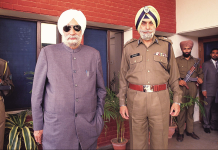Let one thing be clearly understood. History tells us that that there is no Founding Guru of Sikhi, not one of the ten ever sat for a picture or a painting. There exists no record in words, or sketch of what any Guru looked like. Sikhi is absolutely clear no one knows what any Guru looked like. There is no reliable account left by anyone who was a contemporary of the Gurus.
Sikhi clearly teaches that whatever is born of flesh must die. Whether we use the word death for the Gurus or prefer one of many euphemisms like passed away, went to a heavenly abode, or merged with God, it is undeniably true that every one of the ten Gurus in physical form went the way of all flesh.
Yet, being the humans that we are, we look for ways to deny the humanity of our prophets; we think that establishes their divinity and heightens their status.
Just look at how Christianity tries to separate Jesus from the two fundamental experiences that no human being can escape – birth and death. He is supposed to be virgin-born, and to have ascended to the heavens bodily and spiritually after his crucifixion and resurrection. Islam goes a step further, there are no pictures, portraits or icons of Mohammed. Playing Mohammed in film or on stage might become grounds for a Fatwa or Jihad. Mohammed is also said to have ascended to heaven on a horse, hence the Al Aqsa mosque in Jerusalem.
Just look at how Christianity tries to separate Jesus from the two fundamental experiences that no human being can escape – birth and death. He is supposed to be virgin-born, and to have ascended to the heavens bodily and spiritually after his crucifixion and resurrection. Islam goes a step further, there are no pictures, portraits or icons of Mohammed. Playing Mohammed in film or on stage might become grounds for a Fatwa or Jihad. Mohammed is also said to have ascended to heaven on a horse, hence the Al Aqsa mosque in Jerusalem.
On the other hand, Moses has been repeatedly portrayed by actors on stage and film and so has Jesus, with nary a protest. His followers understand the educational value of such events. Hollywood produced many epics on various Biblical characters, including Moses, which helped educate the masses about these historical figures. Moses is considered a prophet by the Jews and by the blockbuster “Ten Commandments” that highlighted Moses remains ever popular even after four decades. Many of us got our early education about the Jews and Judaism from this movie. Some of these Biblical sagas topped the sales of Titanic at the box office.
Last year again, Son of God, a movie on Jesus Christ, sold out entire houses even before its scheduled release.
Sikhi emerged from the cultural realities of Northwest India where two religious cultures Hinduism and Islam collided. In this part of the world, mixed cultural practices and attitudes prevail and in many issues Sikhi is visibly affected.
Sikhi emerged from the cultural realities of Northwest India where two religious cultures Hinduism and Islam collided. In this part of the world, mixed cultural practices and attitudes prevail and in many issues Sikhi is visibly affected.
Clearly in Sikhi the flesh of the Guru-Founders is not important; the ideas and teachings are paramount and eternal.
In India, Sikhi flourishes in a largely Hindu society in which innumerable gods and goddesses thrive. Ordinary mortals portray them in a multitude of movies made every year. Their images on icons are a dime a dozen. Such popular “street art” adorns calendars. Their representations are sold for pennies in the marketplace.
Sometimes actors and actresses who play the part in movies and on stage reap enormous benefits ordinary, uneducated village folk associate holiness and godly qualities to the players and load them with donations, gifts and respect them enormously although their real lives may not deserve it.
Sikhi cringes at the idea of similar things happening to the so called pictures, icons and statues of their Gurus. Hence the Sikh injunction against any human actor playing the role of a Guru on screen or stage. Sounds almost Islamic, doesn’t it?
Sikhi cringes at the idea of similar things happening to the so called pictures, icons and statues of their Gurus. Hence the Sikh injunction against any human actor playing the role of a Guru on screen or stage. Sounds almost Islamic, doesn’t it?
Nothing complicated about these matters so far, one might think, but think again. Humans apparently have a need of visual images of Gurus to relate to; the imagery in worship services is not enough. And our cultural base is largely Hindu.
So, one can buy calendars on street corners adorned by artistic representations of Gurus. Some artists, like Sobha Singh, have been phenomenally successful. What do you think, when Sobha Singh painted a representation of Guru Nanak or Guru Gobind Singh, did a model sit for him or not? Is this a religious crime committed both by the artist and the needy model? In the 1970’s the primary Sikh regulatory body, the SGPC bought the copyright of Sobha Singh’s work and officially gave it their seal of approval.
So, icons and calendars with representations of Gurus can be found in the marketplace as well in many homes and businesses.
We are not defending this widespread custom but we could argue, as many do, that perhaps these representations connect the viewer with the Guru and thus to the message, even if not as cleanly and clearly as we would wish. Why not let the connection flourish and hope for progress?
Of course, that requires tolerance of what exists today coupled with a vigorous continuing program of education on the status of such artifacts, and a policy that is consistent, and not loaded with contradictions.
But there is always a hooker – a however!
An India-based Sikh named Harinder Singh Sikka just made a movie on Guru Nanak. (A disclaimer here that neither of us has seen the movie yet. It hasn’t yet been widely available). Apparently, an actor played the part of Guru Nanak, and all hell broke loose.
The Gurus have themselves emphasized that their physical entity is not important. However, their lives are uniquely tied to the existence of Sikhism. The historical narratives provide inspiration to masses and many try to emulate them. Humans treasure role models and heroes because they provide a sense of hope to many.
The Gurus have themselves emphasized that their physical entity is not important. However, their lives are uniquely tied to the existence of Sikhism. The historical narratives provide inspiration to masses and many try to emulate them. Humans treasure role models and heroes because they provide a sense of hope to many.
The question is how to present these stories and narratives. Dhadees and Kathavachaks narrate with much detail the various incidents and the Gurus’ expressions and reactions which would create a picture in the minds of the listeners. The goal of this was the same,to connect the Sikh to the Guru.
Janamsakhi literature, an elemental Sikh tradition, mixes history, mythology and lore, not unlike many Christian parables. This body of resource material on Guru Nanak and his reaction to various situations is often instructive. How do you capture that and present it in the current social milieu. Technology and virtual reality can do wonders in breathing life into history.
Janamsakhi literature, an elemental Sikh tradition, mixes history, mythology and lore, not unlike many Christian parables. This body of resource material on Guru Nanak and his reaction to various situations is often instructive. How do you capture that and present it in the current social milieu. Technology and virtual reality can do wonders in breathing life into history.
A recent animation on Sikhi, Chaar Sahibzaday, broke all records for any religious movie coming out of Bollywood. Gurdwaras and Sikh families thronged to it; others served langar to encourage viewing. Many non-Sikhs in India saw it and were awed with the stories of these warrior-martyrs.
In contrast stands the example of Sarbans Daani, a recent movie on Guru Gobind Singh. Despite the fact its music was composed by the iconic master Jagjit Singh, the movie flopped on the box office. The likely reason was that it depended on still pictures of Guru Gobind Singh.
In trying new media the question is how far we can go. Remember that paintings and sketches too are imaginative and depend on a model. Keep in mind that the actors’ job is to capture life by stepping into the shoes of the character they portray. There is no assumption that their lives transform into that of the character.
These movies do impact and remain etched in the minds of the people who leave the theaters inspired. We need to explore in the light of the existing ignorance about Sikhi and the lives of our Gurus who founded it. A recent poll revealed that less than 1% of Americans had heard the name of Guru Nanak, and only 8% knew anything about Sikhs. The situation in India may not be much better. Few non-Sikhs have any idea of Sikhism and Guru Nanak.
These movies do impact and remain etched in the minds of the people who leave the theaters inspired. We need to explore in the light of the existing ignorance about Sikhi and the lives of our Gurus who founded it. A recent poll revealed that less than 1% of Americans had heard the name of Guru Nanak, and only 8% knew anything about Sikhs. The situation in India may not be much better. Few non-Sikhs have any idea of Sikhism and Guru Nanak.
How do we fill this abysmal gap? Sikhi and Guru Nanak’s message needs to travel outside the four walls of gurdwaras, our community TV, and radio media. Guru Nanak traveled thousands of miles to get his message across the world.
So we would suggest this. Don’t be busy banning Harinder Singh Sikka’s creative work. Look at it closely. Use the movie for education and tell people why Sikhi is better connected to the word than emotionally attached to a Guru’s physical persona.






[…] Op/Ed: Nanak Shah Fakir, Good for Sikhi or Bad? Some artists, like Sobha Singh, have been phenomenally successful. What do … Dhadees and Kathavachaks narrate with much detail the various incidents and the Gurus' expressions and reactions which would create a picture in the minds of the listeners. Read more on Sikh24 News & Updates […]
Who so ever has written this article can he become Sikh and follow Sikhism and can he get to 90% of what guru Nanak dev ji teached to this world if yes than this film should be screened because Sikhism is 100% correct what he taught even people actor director producer and audience will listen to the movie but will not follow to the teachings of guru Nanak Dev ji there are endless flaws in Muslim Christian and Hindu community which guru Nanak Dev ji objected because they are wrong and still people not admit even writer of this article can’t speak for the humanity for free but when offered money he can speak for truth and against truth and in Sikhism not even a single flaw open challenge anytime .
What he taught to the community that’s why his followers are in every corner of world but after seeing this movie the followers are not going to be double or triple not like that its sound is only in the 4 walls of gurudwara the
What he taught was 100% correct and in 2- 3 hours if you show his teachings to millions of trillions of people not only 100 are going to get benefit from it .millions of people will watch this movie and will be doing crime next day opposite to his teachings .
So this film is 100% money minded ,ram krishan ,Christ also taught good things why not movie on that because earlier movies had made on them this is first time on guru Nanak Dev g so they producers and director want to encash the money just even they are not going to walk on the path showed by guru Nanak Dev g .
So what you call it a business in gods name or you want to show the path to the world .
I say you are making for money only.
Thank you so so much for this article! I don’t think anyone could have hit the nail on the head as you have! Your thoughts and views mirror my exact feelings and you have written them beautifully! Our community really needs to move forward and educate our future generation in means of communication that is suitable for their time, otherwise we will be a very diluted religion! this article you have printed needs to be put on all social network sites and printed in all media in favour of harinder Sikka, and more so in delivering the message of Guru Nanak Deji!
I agree. The facts depicted will educate the movie goers about the Guru’s life and teachings which is so essential in today’s bad times. Today book reading has become rare habit, audio-visual depictions make a great impact on the audience particularly children, adolescent and adults alike. We should encourage such art which depicts the great Guru Nanak Dev.
The cash rich SGPC organises many protests and screams loudly about banning this and banning that…why? because it is a polically led and quite frankly overhyped organisation that does very little to promote Sikhi. The biggest decline of turban wearing youth and the rise in drug addicts has been under its so called tenure.
This is a thought provoking article worthy of sensible debate.
our religion should not be influenced by religious zealots but by reasoned, educated & enlightened discussion. How many of the protesters have seen the film? not many i guess….
An excellent piece of writing – thank you Dr Rajwant Singh!
Being a teacher at a large school of predominantly muslim and christian students, it is appreciated that this film has a huge potential in educating people.
As a british born into a Sikh family, I have seen countless times relatives and people of the community bow at artist impressions of the Guru Sahibs.
I liked the part about Guru Nanak’s message needs to travel outside the four walls of the Gurudwaras. I totally agree that his message has a place everywhere including the workplace.
Seeing the release of this film, I have been very excited as l feel countless people not from the Sikh community will be watching it. What a great way to reach out? Unfortunatley, reading about the widespread protest and seeing banners in India reading ‘This film is the road to hell!’ by protesters leaves a bitter taste to a person trying to get close to the teachings of his ancestor’s spiritual heritage.
People who want to find faults will find them. Those who seek the Truth will see only goodness.
Fairly logical point of view. But, contradictory to above, encouraging such movies will only lead to personification of gurus. Already many of Sikhs bow their heads in front of pictures of Gurus’ which is completely against Sikhism. Idol worship is completely prohibited in our religion.
Though, it seems quiet interesting to let the world know about gurus through such movies. But, are we ready for that? Are we ready for personification of our gurus? Are we ready to intricate a picture of the actor in our mind as Guru.
Pros and cons of everything should be properly analysed before taking any such decision.